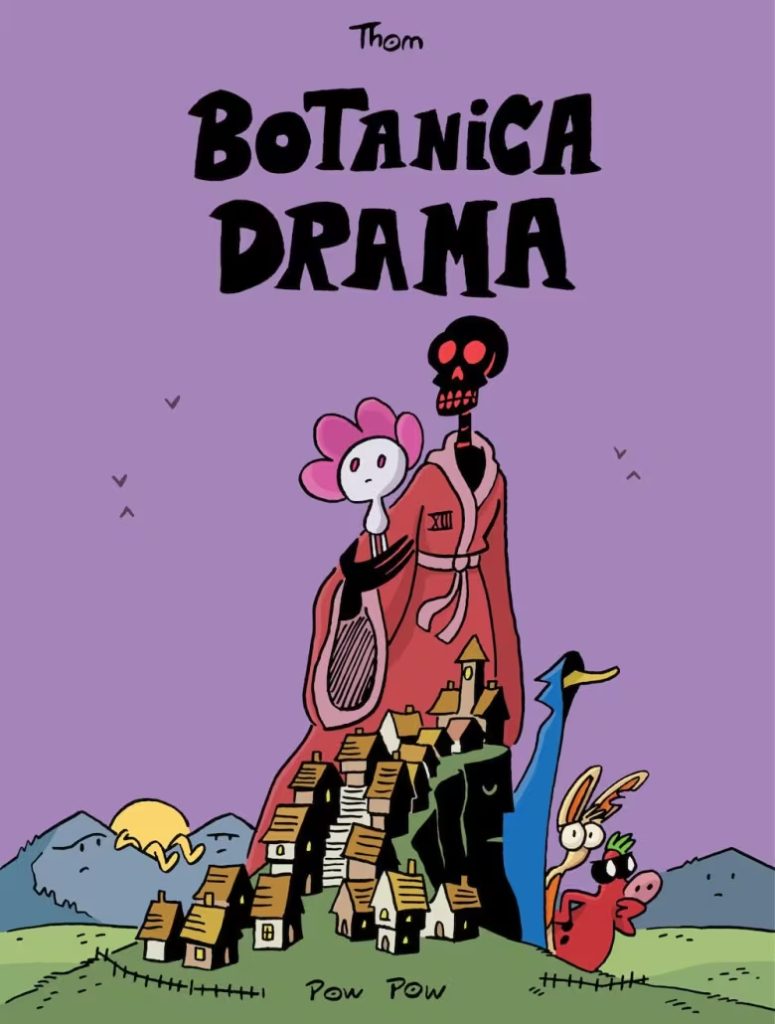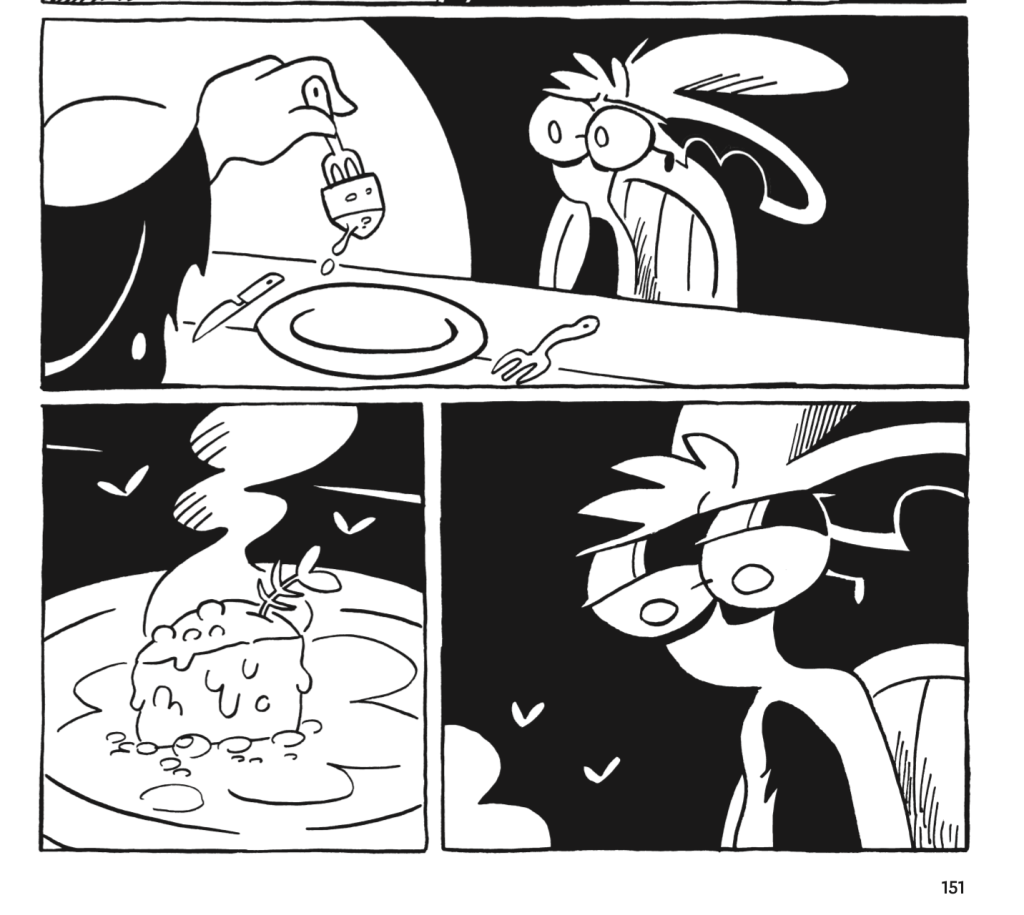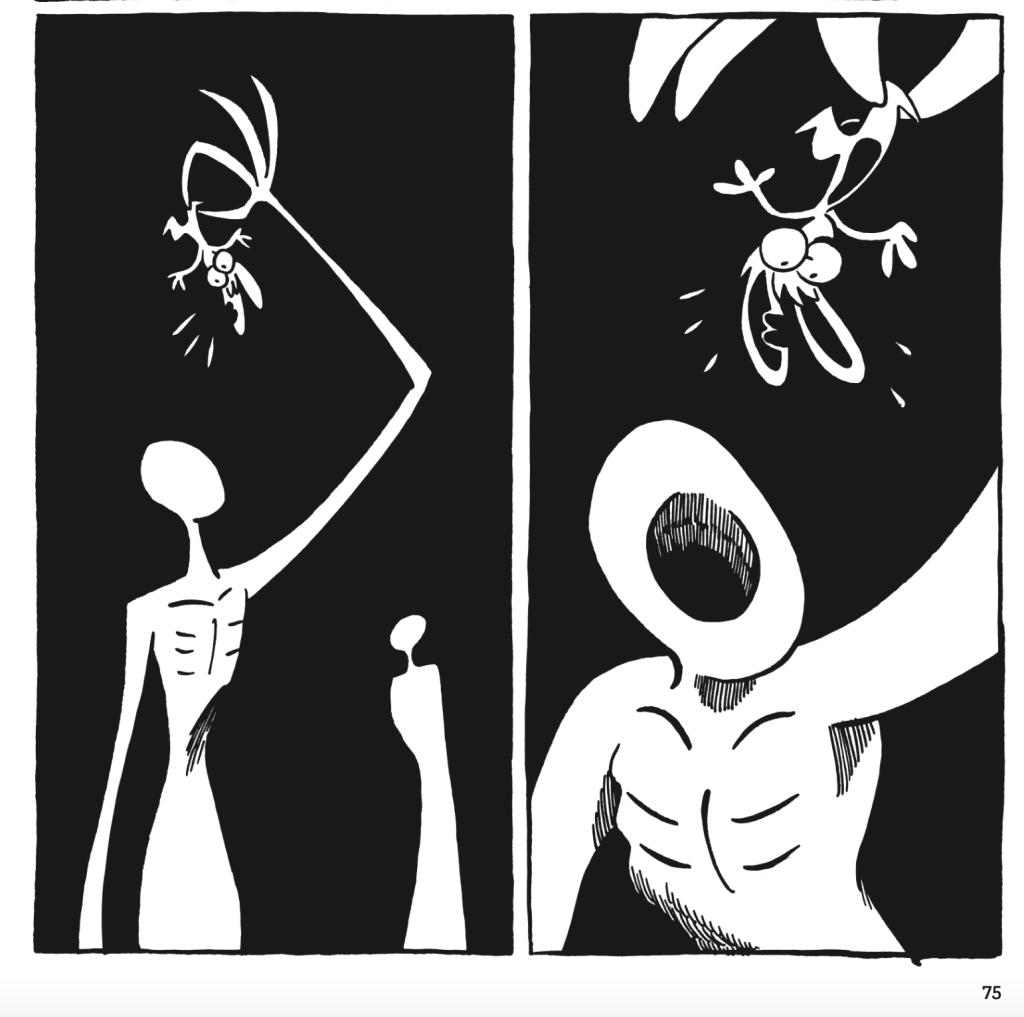
Montreal artist Thom’s Botanica Drama is a wonderful example of how one can tell a compelling, engaging story without using any words. This impressive graphic novel is a new English release of Thom’s French comic, published in Fall 2023 by Éditions Pow Pow. The unique art style and quirky characters leave a strong impression, and Thom’s ability to dive into complex themes through a purely visual medium is incredible. Botanica Drama follows two immortal best friends, the anthropomorphic flower Philomène and a personification of Death, named XIII, who must embarking on the adventure of a lifetime during an apocalypse.
When the Sun decides not to rise one day, a group of willowy pale creatures emerges from caves and wreaks havoc on Philomène and XIII’s small home town of Vauvert. Between their new hostile neighbours and a seemingly everlasting winter, their previously bright world will not survive for long. However, the protagonists’ immortality means little, as they are faced with the destruction of their peaceful home and the deaths of everyone else they know. While Botanica Drama is technically part of a trilogy with recurring characters from Vauvert, each story follows different protagonists.
This personification of death is my favourite of the last few years. Far more laid-back than most depictions, such as Death in Good Omens or even the character in Puss in Boots: The Last Wish, Botanica Drama’s XIII spends much of the story in a bathrobe and takes pleasure in a variety of human activities, such as pastry-making and caring for pet fish. Philomène’s tendency towards curiosity and wandering around to observe the world, even after living for thousands of years, may initially appear naive, but in reality, the flower and XIII are very much alike in their desire to observe and partake in mortal activities. It is precisely XIII’s investment in others’ lives and in the town that makes the story so emotionally poignant; the tragedy of a life cut short is never taken lightly.

Thom perfectly balances the comic’s dark, apocalyptic elements with more lighthearted moments through the familiarity of classic cartoon tropes such as humorous onomatopeia and visual gags. For example, when a pair of apocalyptic preachers with competing signs about the end of the world try to draw in an audience, they both get pelted with tomatoes, and a cartoonish brawl ensues. In another scene, after scavenging for food, a rabbit stares down at the smelly cat food on its plate with a tired, dead-eyed expression that made me smile, despite the dire situation. Thom’s commitment to these gags allows the comic’s more serious scenes, such as when a doglike character starves to death on a cold street, to be all the more impactful.

The bold artistic choices in this work elevate it beyond just an intriguing premise. The strategic use of a restrained black and white palette emphasizes the stark contrast of the night sky with the white earth, and his deliberate transitions to coloured pages at a key emotional point in the story is moving. Many characters’ cartoony, elongated proportions, including XIII’s, are exaggerated further in the designs of the nightmarish creatures, who stand as tall as some of the houses. Along with their featureless faces and their void-like mouths, they are particularly eerie and somewhat reminiscent of Slendermen.
While the comic’s visuals are striking, it is the characters that truly captured my heart. Philomène and XIII appear in Thom’s other works, and their quiet but powerful companionship takes centre stage in this story. Philomène and XIII have been together since the dawn of complex life forms on this planet, and their wordless understanding transcends other dynamics in the book. Thom carefully establishes the dynamics of their relationship in a prologue and also spends a dozen pages showing how they spend time together working at a tiny coffee shop and engaging in their hobbies together afterwards.

One of my favourite pages in the entire comic is a full-page spread in which XIII and Philomène stand with a telescope between them, staring at a particularly bright dot in the night sky. The panel’s lack of dialogue only makes the moment more poignant, as it takes on a meditative quality reminiscent of a painting in a museum. While most of the comic moves at a fast pace to balance out the comedic antics and the serious moments, I most appreciated the scenes in which the story slowed down. It is heartwarming that even as XIII gets busier, they still spend time with each other, making coffee and taking the time to savour it together. These scenes compellingly depict the impact the cold and deaths have on them. Though they continue to show care for each other by making warm, comforting beverages to fight the chill, their silences increasingly take on a new tone: less companionable and more exhausted.
Botanica Drama is exactly the kind of whimsical, thoughtful, artistically unique indie comic I would love to pick up at a convention or book fair. The ending was absolutely on point, with Thom’s denouement offering the perfect resolution to the story and calling back to the prologue in a satisfying way. This comic is a wonderful meditation on life, death, and friendship. No matter if you choose to read it in French or English, Botanica Drama is worth checking out.
An ARC of this comic was generously sent to ImaginAtlas in exchange for an honest review.
